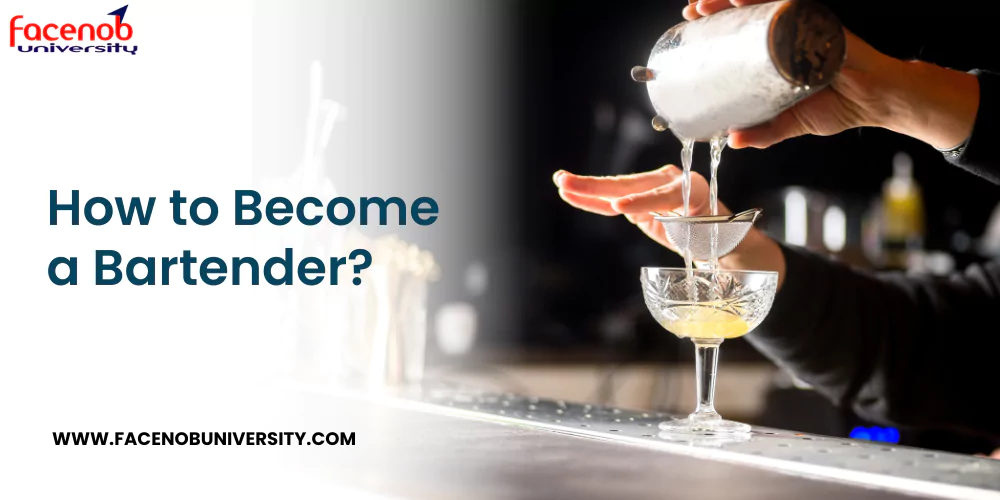How to Become a Bartender?

Introduction of Bartender
Obtain a diploma and academic knowledge. Then work as a barman for six months. Now you’ll be well-educated in listening to stories without rolling your eyes and making every customer feel that their specific demands are being met to perfection.
Similar Job Titles
- Barkeep
- Barman
- Mixologist

Typical Job Responsibilities
What do Bartenders do?
A Bartender would typically need to:
- Manage a bar’s operations; stock and prepare drink garnishes; order and keep an adequate supply of spirits, ice, glasses, and other bar supplies.
- Greet customers, hand out menus and inform them of daily promotions.
- Take and fill alcohol and non-alcohol beverage orders from bar customers, waiters, and waitresses who place drink orders for dining room clients.
- Pour and serve wine, beer, and other beverages; provide bar customers snacks and meals.
- Know various drink recipes and the ingredients for specific drink requests; handle several customized drink orders easily.
- When measuring and pouring liquids, avoid spilling or overpouring. Clean the bars, tables, and workstations; sanitize glassware and utensils.
- Collect consumer payments and refund changes.
- Comply with food and beverage standards; verify client identification to ensure they are of legal drinking age; and monitor customer intoxication levels.
- Work closely with wait staff and other kitchen personnel to provide an exceptional guest experience.
Standard Work Environment
Bartenders primarily work indoors, while some work outside at pools, beach bars, or catered events. Working circumstances differ significantly. Bars in luxury hotels, restaurants, and resorts provide more opulent settings than neighborhood bars. Bartenders must be able to communicate effectively with the general audience. They should also have sound judgment and be willing to refuse service to a customer who has consumed too much alcohol. Some restaurants, particularly those with a high volume of customers, use equipment that automatically measures and pours drinks at the touch of a button. They must maintain a tidy appearance because they are frequently on the front lines of customer service at pubs and restaurants. This is especially true in premium restaurants and pubs where uniforms may be required.
Work Schedule
Bartenders may be required to work more than forty hours a week. They frequently work until late at night and on weekends and holidays. Some bartenders work split shifts, meaning they work for a few hours, then rest before returning to work a few hours later. Part-time jobs are frequently available.
Employers
The most common routes to employment are through a recognized course, an apprenticeship, or direct application. A fifth of all bartenders own the business where they work. Employers most frequently advertise on social media and online job boards. They may also request that their present employees spread the word that they seek new personnel.
Bartenders are generally employed by:
- Restaurants with a Liquor License
- Bars
- Private Clubs
- Civic & Social Organizations
- Hotels
- Ships
- Trains
- Amusement, Gambling & Recreation Industries
- Drinking Joints
Unions / Professional Organizations
Many bartenders are members of labor unions. Professional groups and organizations are essential for bartenders who want to further their professional development or interact with other professionals in their industry or occupation. Membership in one or more organizations adds value to your CV while strengthening your credentials and qualifications.
Workplace Challenges
- The need to spend long hours on their feet while preparing drinks and serving customers
- Under pressure to serve customers quickly and efficiently while ensuring that no alcohol is served to minors or overly intoxicated customers
- Repetitive tasks; need to lift heavy kegs of beer and cases of liquor
- The stress of proactively denying service to intoxicated customers
Suggested Work Experience
Many bartenders advance from other positions inside the places where they work. Some may begin as barman assistants, while others may begin in various professions linked to food and beverage service.
Most bartenders receive on-the-job training, which usually lasts a few weeks and is supervised by an experienced bartender. Aside from everything else, the training focuses on bar setup procedures and complex customer service, including how to deal with aggressive customers. In food service organizations, training may include collaboration and proper food-handling techniques.
Some firms teach bartending skills to new employees through self-study programs, internet programs, movies, and instructional pamphlets explaining service skills. Such programs express the establishment’s ideology, assist new bartenders in building rapport with other workers, and instill a desire to operate as part of a team.
A work trial is frequently part of the hiring process. Prepare to work at least one-hour shifts, performing everyday responsibilities such as conversing with clients, pouring beverages, clearing tables, and processing purchases.
Recommended Qualifications
Those who serve alcoholic beverages must be at least 18 years old. Become a bartender. No formal education is required. Some prospective bartenders, however, attend a bartending school or bartending lessons at a vocational or technical school.
Essential government rules and regulations, cocktail recipes, correct apparel and conduct, and stocking a bar may be included in the programs. Each program’s length varies, but most courses run for a few weeks. Some schools assist their graduates in finding employment.
Certifications, Licenses, and Registration
Those who serve alcoholic beverages must be at least 18 years old. Become a bartender. No formal education is required. Some prospective bartenders, however, attend a bartending school or bartending lessons at a vocational or technical school.
Essential government rules and regulations, cocktail recipes, correct apparel and conduct, and stocking a bar may be included in the programs. Each program’s length varies, but most courses run for a few weeks. Some schools assist their graduates in finding employment.
Projected Career Map
Performance, experience, and the acquisition of professional certifications drive career advancement. Unlike many other occupations, becoming a barman is frequently the initial job on a career path. It would help if you started at the bottom, as with most jobs, sweeping stock room floors or washing glassware.
After demonstrating your ability to operate your station behind the bar, recall the whole beverage menu, manage difficulties, and generally be a confident and reliable staff member, you will be promoted to Assistant Manager or Assistant Bar Manager. A degree and sufficient experience will get you a job with more responsibilities. The Assistant Manager is a full-time employee who receives an annual salary and benefits such as annual leave, sick pay, and superannuation.
The following stage is a more significant leap and is usually filled once the current General Manager leaves the company. This is the big fish; you’re in charge of everything in the bar or restaurant. Unfortunately, this does not include much of the drink preparation or serving. This position is available after approximately ten years of industry experience and qualifications such as a hospitality degree. You would be in charge of all management aspects, including operations, human resources, customer service, public relations, accounting, and increasing sales income. Because this is an executive-level position, you will frequently report directly to the owner.
This is when the story begins to get interesting! You’ve spent the previous 15 years toiling for someone else, and now you have the opportunity, skills, and certifications to open your bar. As the Owner, you create the menus and build out the space precisely like you’ve always imagined in the part of town that you’ve always said would be ideal for a pub.
Like the Owner role, this is you taking charge of your destiny with a lengthy career in the drinks sector. A company Ambassador represents a company to specific clients to raise awareness, develop a specific image, provide sales opportunities, and build customer preference. It is a highly valued position in the alcohol industry.
Job Prospects
Because of the need to replace the numerous individuals who leave the occupation each year, job prospects are likely to be quite good.
Bartending employment in popular restaurants and fine-dining establishments, where tips are highest, is likely to be competitive. Those who have completed bartending programs or have prior work experience and excellent customer service abilities should have the best job prospects.
Beneficial Professional Development
Other than fundamental hotel management courses and personal continuing professional development, there isn’t much you can do to improve your bartending skills after first training.
Professionals commit to increasing personal skills and proficiency through work-based learning, a professional activity, formal education, or self-directed learning as continuing professional development. Numerous CPD courses, seminars, and workshops are available to assist professionals in the sector.
CPD enables people to consistently improve their skills, regardless of their age, career, or degree of expertise. It keeps practical and academic credentials from becoming obsolete. It enables professionals to detect knowledge gaps and advance to a new specialization.
Conclusion
A bartender’s most significant accomplishment is their ability to precisely suit each customer – part philosopher, part psychiatrist, part psychic.
Advice from the Wise
When it comes to their clientele, successful and popular bartenders go above and beyond. They take special care to accommodate the individual needs of every customer, whether they are regulars, infrequent visitors, or first-timers.
Explore Also: How to Become a Barista?
